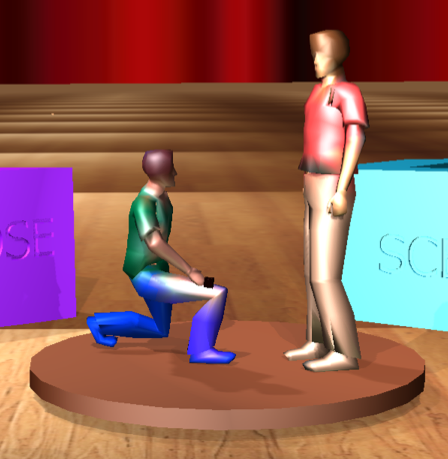Eventually, I decided it would be best to set my scene up like a debate, to show that using the Pentad theory is helpful when analyzing people’s perspectives of cultural topics such as legalization of drugs, vegetarianism, global warming, etc. An issue with two clearly differentiating sides is gay marriage rights. I showed how the motivations of a supporter of gay rights would be obvious by the choices they make to describe a narrative involving a man proposing to another man, and the same would be true for the alternate view.
The video I produced using the Leonar3do system as well as the LeoWorld software displays how the elements can be used to critically analyze arguments.
The video I produced using the Leonar3do system as well as the LeoWorld software displays how the elements can be used to critically analyze arguments.
Part of the assignment for my visual
 interpretation of the theory included making elements that can be printed out three-dimensionally in order to help teach the theory to others. Created using Leonar3do and LeoWorld systems, these objects help to depict the five elements as well as allow for demonstrations of the theory at work. The main item related to the theory is a pentagon “ring” that displays one of the five parts of the pentad on each of its sides. Next is a podium to represent the presence of a “speaker” or “perspective”. I then created a thought bubble in the scene and an object that identifies the speaker’s point of view. Whatever the speaker and text is discussing, should be represented as well. I imagined a narrative about a same sex couple, so they are shown as well. However, part of the activity is that students need come up with their own scenario or find a speech or text that could be described and analyzed using the pentad theory. They then can use the pentagon shape to find the elements within their chosen act, and decide whether the argument or perspective can be easily understood as a communication act.
interpretation of the theory included making elements that can be printed out three-dimensionally in order to help teach the theory to others. Created using Leonar3do and LeoWorld systems, these objects help to depict the five elements as well as allow for demonstrations of the theory at work. The main item related to the theory is a pentagon “ring” that displays one of the five parts of the pentad on each of its sides. Next is a podium to represent the presence of a “speaker” or “perspective”. I then created a thought bubble in the scene and an object that identifies the speaker’s point of view. Whatever the speaker and text is discussing, should be represented as well. I imagined a narrative about a same sex couple, so they are shown as well. However, part of the activity is that students need come up with their own scenario or find a speech or text that could be described and analyzed using the pentad theory. They then can use the pentagon shape to find the elements within their chosen act, and decide whether the argument or perspective can be easily understood as a communication act. The functionality of my scene’s printed objects relies heavily upon facilitating the process of Pentadic Analysis. Rather than just reading a text, hearing a speech, or looking at an image, these pieces help visualize the analysis. It is actually more difficult to go about understanding the Pentad Theory this way, and by the end they should know more about it and be able to explain it better since they have worked through all the manners in which it can be described. By setting up an ambiguous representation of a speaker and using the pentagon pentad, they can identify the five elements in Burke’s theory to examine the rhetoric. This is important because it exemplifies how Burke’s theory can be utilized as a critical thinking tool. Being able to recognize the act, agent, agency, scene, and purpose behind a message allows for better decision making in order to decide whether to absorb or reject the information in a useful way. My objects are available for download in the .obj format at: https://drive.google.com/folderviewid=0B0fIsxtWF8N_a05TMkpRNU9JOFE&usp=sharing
I learned a couple notable things throughout this particular assignment. Using Leo to illustrate this theory really helped me understand it better than I had when I only read the summary of it. At first, I misunderstood the function of it, and after having to actually see the idea somehow in my mind and think about showing it in a way it could be easily shared with other allowed me comprehension beyond what I initially received.The one thing I was not anticipating was how long completing this entire project would actually take. Each session I had working with the Leo system lasted no shorter than three hours, and that is with little trouble-shooting, so any larger set back with the technology caused me more stress than if I had planned out my time more efficiently. So for our next comprehensive assignment, I will better prepare for that consideration.


No comments:
Post a Comment